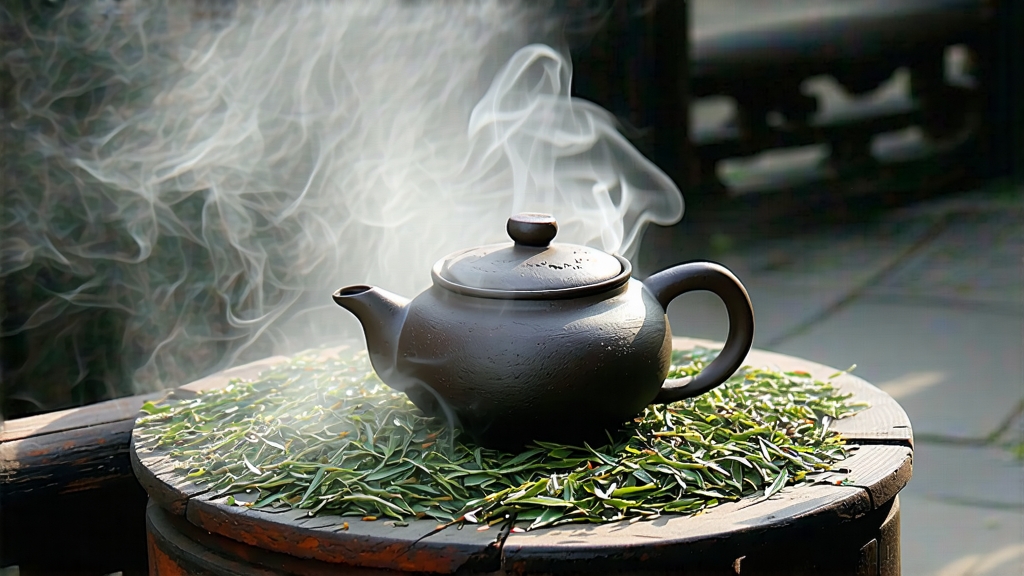
Long before Assam, Ceylon, or Earl Grey entered the English lexicon, the first fully oxidised leaf ever to leave China sailed out of the little river port of Xingcun in Fujian’s Wuyi Mountains. Dockhands labelled the chests “Lapsang Souchong”—“smoky sub-variety from Lapu Mountain”—and Londoners tasted, then swooned over, a tea unlike anything green or oolong. That 1604 shipment marks the birth of black tea itself; every later variety, from Keemun to Darjeeling, is a grand-child of this pine-scented ancestor.
History: Legend places the invention in a military camp. Qing soldiers, so the story goes, commandeered a tea factory during the late Ming dynasty. By the time farmers reclaimed their withering leaves, oxidation had run too far for green-tea standards. To salvage the crop they rushed the leaf over pinewood fires normally used for drying, and the accidental smoke gave the world a new flavour. Merchants at the Dutch East India warehouses paid triple the price of green tea, and within decades bohea (the European corruption of “Wuyi”) became the fashionable drink of Samuel Pepys, Madame de Sévigné, and Catherine of Braganza, who popularised tea at the English court.
Terroir & Cultivars: Authentic Lapsang Souchong can only be born in the 650–1,500 m granite gorges of Tongmu Guan, a protected enclave inside the Wuyi National Nature Reserve. Here, morning fog diffuses the subtropical sun, slowing photosynthesis and concentrating amino acids. Two hyper-local cultivars dominate—Xiao Zhong Ye (“small-leaf type”) and the even rarer Wu Niu Zao (“black-bull early”), whose petite, spring-picked buds contain twice the geraniol that later translates into smoky-sweet lychee notes. Outside the reserve, farmers grow a larger-leaf imitation called “Waishan Xiaozhong,” but connoisseurs dismiss it as flat and bluntly tarry.
Crafting the Smoke: The process begins like any black tea—pluck, wither, roll—yet diverges dramatically at the firing stage. Fresh one-bud-two-leaf sets are spread on bamboo trays inside smoke-less upper rooms of 200-year-old wooden factories. A gentle 70 % wither under natural mountain breeze reduces moisture to 60 %. Rolling is still done by foot inside a 1.2 m diameter bamboo drum: the craftsman rocks barefoot, his weight bruising cells evenly without overheating the leaf. Oxidation follows in humid chestnut-wood chests; the leaf turns copper within two hours. Then comes the signature pinewood smoke-dry. Downstairs, a pit burns resin-rich Masson pine and local Chinese red pine; the rising 80 °C smoke travels through brick flues, never touching the leaf directly, perfuming it for eight to ten hours. Masters judge readiness by sound: when the crackle of a handful equals the crunch of autumn leaves, the tea is finished. A final charcoal bake, using 40-year-old pit embers, stabilises the moisture at 3 % and layers in caramelised depth.
Grades & Styles: Tongmu producers now differentiate three grades. “Traditional Lapsang” uses only spring buds, smoked heavily, yielding glossy black strips and a campfire nose. “New-style Lapsang” (sometimes marketed as “unsmoked” or “fruit-lapsang”) omits the pine step, letting the natural honey-fruit notes speak; it resembles a Keemun but carries Wuyi minerality. “Wild Lapsang” is harvested from self-seeded bushes on cliff edges, mixed with sweet gum and chestnut wood for a cooler smoke, giving a menthol-tinged finish that lingers like eucalyptus.
Chemistry in the Cup: Gas-chromatography studies reveal that the pine stage imparts guaiacol, 4-methyl-guaiacol, and eugenol—compounds also found in whisky barrels. These bond with the tea’s own linalool and geraniol, creating the illusion of smoked peaches and longan. The absence of polycyclic aromatic hydrocarbons (PAHs) in properly smoked leaf reassures health authorities; smoke never combusts onto the tea, it merely flavours the circulating air.
Brewing: Western vs. Gongfu.
Western: 2.5 g per